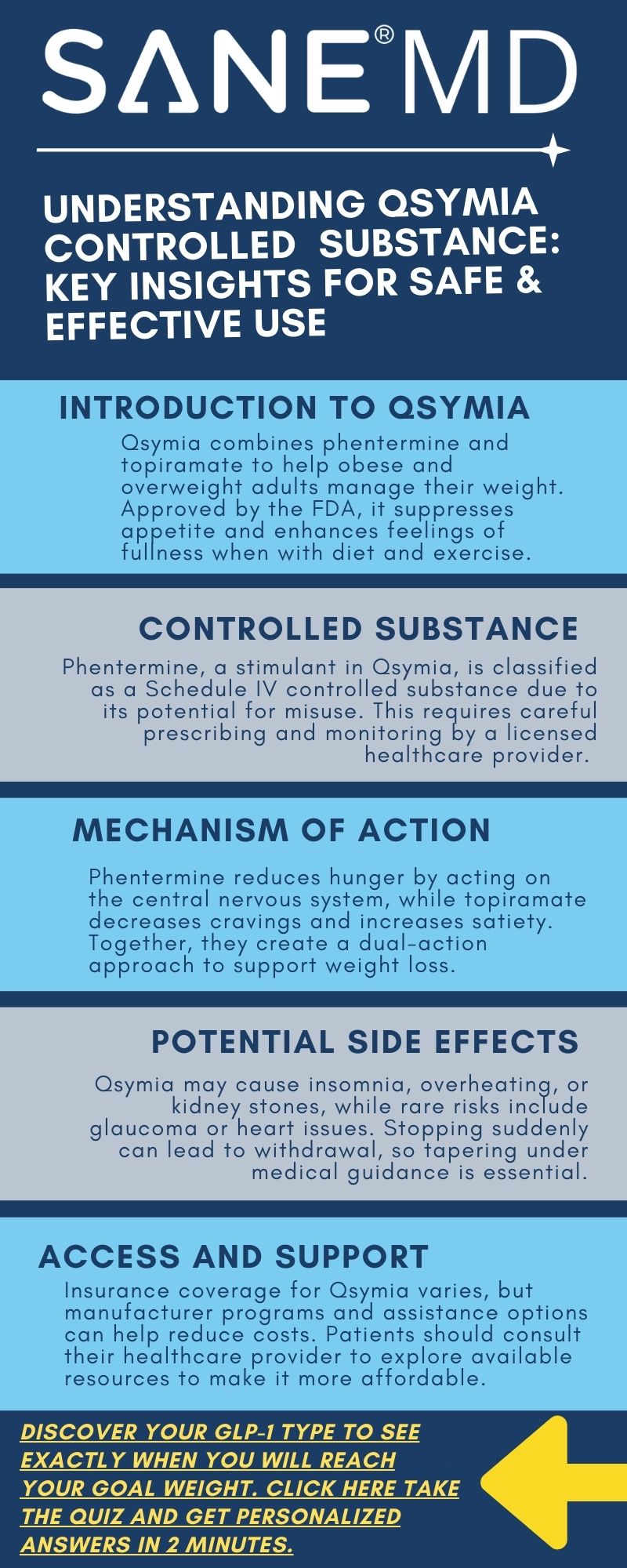Qsymia Controlled Substance: Understanding the Implications
Dr. Matthew Olesiak, MD, is the Chief Medical Director at SANESolution, a renowned wellness technology company dedicated to providing evidence-based solutions for optimal living. Dr. Olesiak earned his medical degree from the prestigious Jagiellonian University Medical College in Kraków, Poland, where he developed a strong foundation in medicine.
Qsymia, a combination of phentermine topiramate (Qsymia) extended-release capsules, is a medication approved for chronic weight management in obese and overweight adults. Recognized as a Schedule IV drug, Qsymia is classified as a controlled substance due to its potential for drug dependence and misuse.
This article explores its designation, usage, and critical considerations for those prescribed this medication.
Introduction to Qsymia
Qsymia is a prescription medication that combines phentermine and topiramate, two active ingredients that work synergistically to promote weight loss in obese and overweight adults. Phentermine acts as a centrally acting appetite suppressant, helping to reduce hunger and food intake.
Topiramate, originally an antiepileptic agent, has been found to have weight loss properties, contributing to a decrease in food cravings and an increase in feelings of fullness.
Approved by the FDA for chronic weight management, Qsymia is intended for compatible adults with a body mass index (BMI) of 30 or higher, or those with a BMI of 27 or higher who have at least one weight-related condition, such as high blood pressure, type 2 diabetes, or dyslipidemia.
This combination therapy aims to support significant weight loss and improve overall health outcomes in overweight adults. If you’re wondering if taking Phentermine alone is better than Qsymia for weight loss, check out our Qsymia vs. Phentermine guide.
What Class of Drug Is Qsymia?
Qsymia controlled substance belongs to a class of medications known as centrally acting appetite suppressants, designed to support compatible individuals in achieving and maintaining weight loss. This prescription medication combines two active ingredients, phentermine and topiramate, which work synergistically to suppress appetite and promote weight reduction.
Phentermine, a Schedule IV controlled substance, is a stimulant that primarily targets the central nervous system to suppress hunger signals. By increasing the release of norepinephrine, it helps curb appetite, making it easier for individuals to adhere to a reduced-calorie diet. Its effects are most notable in the early stages of treatment when motivation and appetite control are critical.
Topiramate, originally developed as an anticonvulsant, enhances the weight loss effects of phentermine through several mechanisms. It appears to influence the brain’s reward centers, potentially reducing cravings and emotional eating. Additionally, topiramate may provide metabolic benefits by improving insulin sensitivity and influencing energy balance, further aiding in weight loss.
Together, these components create a dual-action approach: phentermine reduces hunger and promotes dietary adherence, while topiramate supports sustainable weight loss by addressing underlying metabolic and behavioral factors. This combination therapy has been shown to be more effective than either component alone, offering certain individuals a powerful tool for managing obesity when paired with a comprehensive weight loss program that includes dietary and lifestyle changes.
Healthcare providers typically recommend Qsymia as part of a long-term strategy for weight management, emphasizing the importance of regular medical monitoring to ensure its safe and effective use.
Why Is Phentermine a Controlled Substance?
Phentermine is classified as a Schedule IV controlled substance in the United States due to its stimulant properties, which bear similarities to amphetamines. These properties can increase the risk of misuse, dependency, and abuse, even though the potential for addiction is relatively low compared to higher-schedule substances. This classification reflects a balance between recognizing phentermine’s therapeutic benefits for weight loss and addressing concerns about its misuse.
Phentermine primarily works by stimulating the central nervous system (CNS), increasing levels of certain neurotransmitters like norepinephrine. This action suppresses appetite, making it a valuable tool for short-term weight management. However, because it affects the CNS, phentermine may produce side effects such as increased heart rate, elevated blood pressure, and heightened alertness, which can make it appealing to those seeking its stimulant effects for non-medical reasons.
As a component of Qsymia, phentermine’s inclusion highlights the importance of careful prescribing practices and strict adherence to risk evaluation and mitigation strategies (REMS). These strategies are designed to ensure that the medication is used safely and appropriately. Physicians prescribing Qsymia must evaluate each patient’s health profile, monitor for potential side effects, and consider contraindications such as a history of substance abuse or cardiovascular conditions.
In addition to prescriber oversight, patients using medications containing phentermine are typically advised to follow their healthcare provider’s guidance closely. This includes taking the medication only as directed, avoiding dose escalation, and reporting any side effects or concerns immediately. Such precautions are essential for mitigating the risks associated with phentermine while maximizing its effectiveness as part of a comprehensive weight management plan.
Overall, the controlled status of phentermine reflects a commitment to balancing its potential risks with its significant benefits when used under proper medical supervision.
Mechanism of Action and Pharmacokinetics
The exact mechanism of action of Qsymia is not fully understood, but it is believed to involve the suppression of appetite and the enhancement of satiety. Phentermine works by stimulating the release of norepinephrine, a neurotransmitter that helps regulate appetite and metabolism, acting as a centrally acting appetite suppressant. Topiramate, on the other hand, is thought to affect the brain’s reward system, leading to a decrease in food cravings and an increase in feelings of fullness.
Qsymia is well absorbed when taken orally, with peak concentrations reached in approximately 6 hours for phentermine and 10 hours for topiramate. The half-life of Qsymia is about 20 hours for phentermine and 65 hours for topiramate, allowing for once-daily dosing. This pharmacokinetic profile supports its effectiveness in promoting weight loss and managing body weight over the long term.
The Role of Qsymia in Chronic Weight Management
Qsymia is indicated for obese and overweight adults with weight-related comorbidities such as high blood pressure or type 2 diabetes. Clinical trials have demonstrated its efficacy in helping patients lose weight and achieve clinically meaningful weight loss, often exceeding results seen in patients taking a placebo.
Most patients experience significant reductions in body weight when paired with a reduced-calorie diet and increased physical activity.
Take the Qsymia quiz to see if this dual-action drug is right for you.
Key Considerations for Qsymia Treatment
Controlled Substance Status
As a Schedule IV drug, Qsymia requires a prescription from certified pharmacies. Health professionals emphasize the importance of adhering to prescribed dosages to minimize risks associated with drug dependence and adverse effects.
Risk Evaluation and Mitigation Strategies
Patients must undergo a comprehensive risk evaluation before starting treatment. This includes assessing for conditions like secondary angle closure glaucoma, metabolic acidosis, and mood disorders. Regular follow-ups ensure that the treatment remains safe and effective.
Negative Pregnancy Test Requirement
Qsymia carries a black box warning for potential teratogenic effects, including cleft lip and cleft palate. Women of childbearing age must provide a negative pregnancy test before starting Qsymia and use effective birth control throughout the treatment.
Dosage and Administration
Qsymia is available in four strengths: 3.75 mg/23 mg, 7.5 mg/46 mg, 11.25 mg/69 mg, and 15 mg/92 mg. The recommended starting dose is 3.75 mg/23 mg once daily in the morning, with or without food. After 14 days, the dose can be increased to 7.5 mg/46 mg. If additional weight loss is needed, the dose may be further increased to 11.25 mg/69 mg or 15 mg/92 mg, based on the patient’s response and tolerance.
Patients should be instructed to take Qsymia once daily in the morning to minimize the risk of insomnia, a common side effect associated with phentermine. Consistent timing of the dose helps maintain stable drug levels in the body, enhancing the medication’s effectiveness in supporting weight loss.
Monitoring and Follow-Up
Patients taking Qsymia should be monitored regularly for changes in weight, blood pressure, and other health parameters. A negative pregnancy test is required before starting Qsymia, and women of childbearing age should use effective birth control while taking the medication to prevent potential teratogenic effects.
Monitoring for signs of secondary angle closure glaucoma, a rare but serious side effect of Qsymia, is also crucial. Regular follow-up appointments with a healthcare provider are necessary to assess the effectiveness of Qsymia, adjust dosages if needed, and monitor for potential side effects. This comprehensive approach ensures that the treatment remains safe and effective for chronic weight management.
Potential Side Effects and Precautions
Qsymia, while effective for weight management, is associated with potential side effects and precautions that users must consider. These effects can range from mild to severe and require careful monitoring to ensure safe and effective use of the medication.
Common Side Effects
Patients taking Qsymia may experience a variety of side effects. Some of the more frequently reported ones include:
- Trouble Sleeping (Insomnia): The stimulant properties of phentermine can disrupt sleep patterns, leading to difficulty falling or staying asleep. Patients are advised to take the medication in the morning to minimize this effect.
- Decreased Sweating: Topiramate can reduce the body’s ability to sweat, increasing the risk of overheating, particularly during physical activity or in hot environments.
- Increased Body Temperature: In combination with decreased sweating, this side effect can lead to heat intolerance, requiring caution in high temperatures.
- Severe Pain Associated with Kidney Stones: Topiramate has been linked to an increased risk of kidney stone formation. Patients are encouraged to stay well-hydrated to reduce this risk.
Serious Risks
While rare, Qsymia can cause serious side effects that require immediate medical attention:
- Secondary Angle-Closure Glaucoma: This condition involves a sudden increase in eye pressure, leading to pain, blurred vision, and potential vision loss. Immediate treatment is necessary if symptoms occur.
- Myocardial Infarction (Heart Attack): Though uncommon, Qsymia has been associated with cardiovascular events. Patients with a history of heart disease should be closely monitored.
- Serious Skin Reactions: Severe rashes, blistering, or peeling may indicate a rare allergic reaction. Discontinuation of the medication may be necessary in such cases.
- Metabolic Acidosis: Topiramate can cause an imbalance in the body’s acid-base levels, leading to symptoms such as fatigue, confusion, or rapid breathing. Regular blood tests may be required to monitor for this condition.
Stopping Qsymia Suddenly
Abrupt discontinuation of Qsymia is not recommended due to the risk of withdrawal symptoms, particularly with the topiramate component, which can lead to seizures in some cases.
Patients are advised to work with their healthcare provider to gradually taper off the medication, ensuring a safe discontinuation process and minimizing any potential adverse effects.
Insurance Coverage for Qsymia
Cost and Accessibility
Insurance coverage for Qsymia can vary widely depending on the provider, plan, and individual circumstances. While some insurers may cover the medication under their obesity or weight management benefits, others may require prior authorization or deny coverage entirely.
Patients should verify their coverage directly with their insurance company to understand their options.
Manufacturer Discounts and Assistance Programs
For patients facing high out-of-pocket costs, Qsymia’s manufacturer often provides cost-saving programs or discounts.
These may include:
- Savings Cards: Eligible patients can receive discounts on their prescriptions to reduce monthly costs significantly.
- Patient Assistance Programs: These programs are designed to help those with limited income or without insurance access the medication at a reduced cost or for free.
- Pharmacy Partnerships: Certain pharmacies may offer special pricing or discounts for Qsymia prescriptions.
Other Financial Assistance Options
Patients may also consider exploring third-party assistance programs or nonprofit organizations that specialize in providing financial support for prescription medications. Healthcare providers and pharmacists can help identify and apply for these resources.
By understanding potential costs and available financial assistance options, patients can access Qsymia more affordably and ensure the continuity of their weight management plan.
Addressing Frequently Asked Questions
1. Is Topiramate a Controlled Substance?
Topiramate itself is not classified as a controlled substance because it lacks the stimulant properties associated with substances like phentermine. However, its inclusion in Qsymia plays a significant role in enhancing the medication’s effectiveness for weight loss.
By influencing appetite control and providing metabolic benefits, topiramate complements phentermine’s appetite-suppressing action, making the combination therapy more effective than either component alone.
2. What Are the Potential Concerns or Limitations with Qsymia?
While Qsymia has been shown to be effective for weight loss, it may not be appropriate for everyone.
Potential concerns include:
- Side Effects: Common side effects include dry mouth, insomnia, dizziness, and tingling sensations. In rare cases, more serious side effects such as mood changes, memory issues, or metabolic disturbances may occur.
- Drug Interactions: Qsymia may interact with other medications, including anticonvulsants, antidepressants, or medications that affect heart rate or blood pressure, requiring careful medical evaluation.
- Controlled Substance Status: The inclusion of phentermine, a Schedule IV controlled substance, necessitates strict prescribing practices to prevent misuse or abuse.
- Pregnancy Risks: Qsymia is contraindicated during pregnancy due to the risk of birth defects, and effective contraception is essential for women of childbearing age using this medication.
- Suitability: Qsymia is typically prescribed for individuals with a BMI of 30 or higher or those with a BMI of 27 or higher and a weight-related condition such as hypertension or diabetes. It may not be appropriate for those with a history of substance abuse, cardiovascular issues, or certain mental health conditions.
Understanding these factors is crucial for determining whether Qsymia is a suitable and safe option for weight management. Consulting with a healthcare provider is essential to weigh the benefits and risks based on individual health needs.
Optimizing Weight Loss with Qsymia
For optimal results, Qsymia should be paired with a reduced-calorie diet and regular physical activity. Patients should maintain open communication with health professionals to address any concerns during treatment.
Take this quiz to determine if Qsymia aligns with your weight loss goals.
Conclusion
Qsymia’s designation as a controlled substance reflects its efficacy and potential risks. When prescribed responsibly and paired with lifestyle modifications, it serves as a powerful tool for achieving significant weight loss in obese and overweight adults.
Understanding its benefits, precautions, and proper usage can help patients and health professionals navigate its role in chronic weight management.





